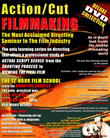|
|
FEATURES
- Film
Editing
|
 |
|
|
|
|
|
|
|
|
| Sponsors |

|
|
|
 |
|
 |

|
|
Film Editing - page 6
|

|
|
Postproduction film editing follows a series of stages similar to videotape editing, from preliminary editing that includes viewing a copy of the originally recorded images, called the
work print, rushes, or dailies and selecting and ordering specific shots and scenes, called rough cutting, to final editing, called conforming.
Unlike videotape editing, film is spliced mechanically. Film images can, however, also e transmitted to videotape so that they can be edited electronically. Carol Littleton feels however that it doesn't really matter what you edit on. They are just tools
(KEM, Moviloa, etc).
The choice between electronic and mechanical editing techniques is a simple decision in some areas and is more complex in others. Film editing can seem quite laborious and time-consuming, but this is not always the case.
For example, it is much simpler to shorten or lengthen an entire film by a few frames during preliminary film editing. A film editor has a great deal of freedom to experiment with a variety of different takes and shot sequences and duration's at all stages of the editing process.
A copy made from the originally recorded film is called a work print. The film director usually specifies which camera takes should be printed during production. The editor, director and producer view each day's
work print in order to evaluate how well things are going.
|
|

|

|
|
all shots to be made at one location are recorded at the same time, regardless of when they occur in the script, the editor must assemble the shots into the order specified by the script
|
|

|
|
|
After viewing and
approving the footage, the editor catalogues it before beginning a rough cut. An
editor will often view the dailies over and over again to get a feel for the
production and to stimulate ideas about how images can and should be combined.
The next stage of preliminary editing is to assemble the individual shots into sequential order. Since films are often shot out of continuity, that is, all shots to be made at one location are recorded at the same time, regardless of when they occur in the script, the editor must assemble the shots into the order specified by the script. During the assemble stage of editing; the entire shot is left intact.
As the rough cut progresses and each shot is placed in its proper sequential order, the editor gradually refines the cuts, cutting out all extraneous or unnecessary material. Unused shots are called outtakes. They are often left on the original camera rolls.
The pieces removed from the shots that are actually used are called trims. They are frequently stored on the pegs of a trim bin, which is placed near the editing bench. Trims are sometimes spliced back into the film after the editor has tried a specific cut, usually because the cut does not work quite as well as was anticipated.
|
|

|
|
|
|
|
|
|
|

|
|
|

|

|
|
top of page
|
Home
Page |
Contests
| Indies
| Features
| News
| Resource
Links
| Advertise
With Us |
Important
disclaimer
Copyright ©
1999-2011 by FilmMakers.com. All rights reserved.
FilmMakers.com
is a division of Media Pro Tech Inc.
|

|
|
|